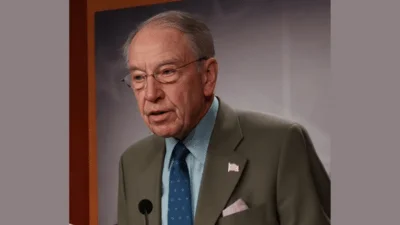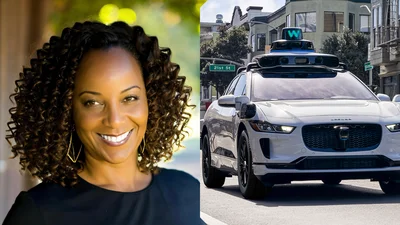The Congressional Record is a unique source of public documentation. It started in 1873, documenting nearly all the major and minor policies being discussed and debated.
“REMEMBERING HENRY HAMPTON ``EMINENT FILM--MAKER''” mentioning the U.S. Dept. of Commerce was published in the Extensions of Remarks section on pages E471-E473 on March 17, 1999.
The publication is reproduced in full below:
REMEMBERING HENRY HAMPTON ``EMINENT FILM--MAKER''
______
HON. WILLIAM (BILL) CLAY
of missouri
in the house of representatives
Wednesday, March 17, 1999
Mr. CLAY. Mr. Speaker, Henry Hampton, my friend and fellow student at St. Nicholas Catholic School in St. Louis, Missouri, was a prominent film-maker who shaped the American documentary world. While at St. Nicholas, a very small school with 100 students in grades K-12, I was a high school student and Hampton was a grammar student. Hampton went on to graduate from Washington University in St. Louis. For 30 years right up until his death on November 22, 1998, Hampton raised the American conscience through such award winning documentaries as Eyes on the Prize, Voices of Freedom: An Oral History of America's Civil rights Movement, The Great Depression, America's War on Poverty, Malcolm X: Make it Plain, and Breakthrough: The Changing Face of Science in America. In all Hampton produced or was responsible for more than 60 major films and media projects for the public and private sectors. Through film, Hampton became a civil rights leader as well as an educator.
Among his many industry awards and community honors are the prestigious duPont-Columbia and Peabody awards for excellence in broadcast journalism, as well as six Emmys and an Academy Award nomination. Also, Hampton received the 1993 Ralph Lowell Award, considered the highest recognition in public television, presented by the Public Broadcasting Service and the Corporation for Public Broadcasting. In 1994, Hampton received the first Harold C. Fleming Award recognizing ``a lifetime of service in the field of political participation and community education against hatred in politics.'' In 1995, he received the first Heinz Family Foundation Award in the field of arts and humanities. I commend to our colleagues the January-
February 199 About . . . Time article, title ``An Eye for the Prize,'' which tells of the great contributions of Hampton.
An Eye For The Prize
Through the Art of Film and Story, Henry Hampton Celebrates the Sweep of African-American Struggles and Creativity
By Wanda S. Franklin
The one thing he did right was the day he started to fight. With cameras and lights. Producers and editors. Historians and history's forgotten soldiers,'' Boston Globe columnist Derrick Z. Jackson wrote in a tribute to the life and works of Henry Hampton, on November 28, six days after the eminent film-maker died. Now, many African Americans and others inspired by Hampton's legacy are beginning to take an accounting of his work.
As founder and president of Blackside, Inc., Hampton made uniquely important contributions to the body of American documentary film over the past 30 years right up until his death on November 22, 1998. He leaves behind a tremendous legacy that not only shaped the world of documentary film, but also the American conscience.
`I believe in the power of the arts to create positive change,'' said Hampton, the creator and executive producer of the award-winning multi-part documentary, Eyes on the Prize. The series, released in two installments (with six episodes in 1987 and another eight episodes in 1990), won the prestigious duPont-Columbia and Peabody awards for excellence in broadcast journalism, as well as six Emmys and an Academy Award nomination. Eyes on the Prize is regarded as the definitive film record of America's civil rights movement. Hampton also co-authorized the companion volume, Voices of Freedom: An Oral History of America's Civil Rights Movement.
In his years at Blackside, Hampton produced or was responsible for more than 60 major films and medial projects, including several for J. Walter Thompson advertising agency, the United States National Institute of Mental Health and the United States Department of Commerce.
Through his filmmaking, Hampton became a messenger, even a propagandist for justice, equity and fairness. The stories he produced became political weapons and tools for learning.
Hampton was executive producer for all of Blackside's PBS film projects including. The Great Depression, America's War on Poverty, Malcolm X: Make it Plain, and BreakThrough: The Changing Face of Science in America. His efforts presented unfold stories behind America's most critical issues--leadership, the nature of democracy and freedom of expression.
He worked around personal disabilities and other illness. Hampton was struck by photo at the age of 15. He also battled lung cancer and pericarditis before he died from a bone marrow disease which arose from a treatment for the lung cancer. Perhaps his suffering became his grace. Henry Hampton refused to be a victim. He learned how to listen without being judgmental.
From the late 1960s through 1990, Hampton chaired the Museum of Afro American History's board of directors, leading that organization's campaign to acquire and restore the African Meeting House on Boston's Beacon Hill, the oldest standing African-American church building in the United States.
Hampton's thirteen honorary degrees include one from his alma mater, Washington University in St. Louis, Brandeis University, Boston College, and most recently from Tufts University in Boston. Among his many industry awards and community honors is the 1993 Ralph Lowell Award, considered the highest recognition in public television, presented by the Public Broadcasting Service and the Corporation for Public Broadcasting. In 1994, Hampton received the first Harold C. Fleming Award recognizing ``a lifetime of service in the field of political participation and community education against hatred in politics.'' In 1995, he received the first Heinz Family Foundation Award in the field of arts and humanities.
The success of his productions and numerous awards speak to his strengths as a visionary and storyteller, as well as to his superb filmmaking style. Hampton once said of Eyes on the Prize, ``I like big stories. One of the problems with history is that often you get marvelous small stories. But if you don't put them in a larger frame, they don't have as much impact. Eyes on the Prize was successful beyond my wildest dreams because it took history that people thought they knew and gave it a sweep. We hit these high stories along the way and showed how they are part of a rising tide,'' he told Paul Kahn during an interview for Very Special Arts Massachusetts. VSAMASS is a non-profit organization that seeks to create and promote opportunities in the arts and cultural mainstream for people with disabilities.
Hampton's ability to see and evaluate the strength and beauty in ordinary people and to powerfully document their struggles and accomplishments within the course of history is what made his work so memorable. He saw the value in the work of the foot soldiers as well as the leadership and acknowledged both. The ``prize'' was inherent in the struggle for one's beliefs.
By presenting those powerful little stories of the ``faces of the unfamiliar'' was how Hampton ``unveiled black people as civilized warriors'' and captured ``the depth of commitment of freedom marchers who went to jail with none of the publicity given to movement leaders,'' wrote Jackson.
A challenge was also issued in Jackson's Boston Globe column on behalf of the independent filmmaker. ``Although Hampton has passed from us, I believe his eyes and spirit are cast down toward us. He is watching to see how we protect the prize. He is watching to see how well we hold on,'' Jackson wrote.
Unique aspects of history are sure to be repeated again when another of Hampton's works, I'll Make Me a World: A Century of African-American Arts, premiers nationally on PBS February 1-3, 1999, at 9 p.m. ET (check your local listings). A production of Blackside, Inc., in association with Thirteen/WNET, this unprecedented six-hour documentary series celebrates the extraordinary achievements of the African-American creative spirit in the 20th century.
The work captures the stories behind 100 years of tumultuous struggle for identity, equality and self-expression by the artistic talent in the African-American community. ``This production is a soaring, celebratory and informative journey into the powerful interaction between African-American culture and the larger American society,'' Hampton said after completing the documentary.
I'll Make Me a World: A Century of African-American Arts is the last production completed by the late filmmaker. However, Hampton was at work on two other major projects. Hopes on the Horizon: The Rise of the New Africa, a ten-part film project covering developments in Africa from 1945 to the present, is scheduled to be completed in 2001. The African American Religious Experience was completing the research and development stage and is expected to go into production this spring. This project examines the shifting role of churches that are being challenged to meet the spiritual needs of young people. These projects will be continued by the Blackside Inc. production team.
I'll Make Me a World: A Century of African-American Arts definitely presents another extraordinary work by Hampton, documenting compelling stories of struggle and creativity in the black arts experience. The series gives voice to the jazz, blues and rap that have defined American music, and the fiction and poetry that have challenged conventional ideas about family, community, race and democracy. It also showcases powerful visual images, from canvas to movie screen that have interpreted the African-American experience as well as the innovative dance and theater that have created new forms of expression embraced by enthusiastic audiences worldwide.
I'll Make Me a World is narrated by Vanessa L. Williams. The star-studded roster of artists, critics and scholars who will offer insightful commentary and analysis also includes Quincy Jones, Alice Walker, Wynton Marsalis, Gwendolyn Brooks, Bill T. Jones, Jacob Lawrence, Amiri Baraka, Spike Lee, Ben Vereen, Melvin Van Peebles, Cornel West and other on-screen witnesses.
I'll Make Me a World: A Century of African-American Arts is a rich tapestry of sights and sounds highlighting black artists of every creative discipline whose distinctive talents have shaped American culture in the 20th century. What the viewer will see over the course of the three evenings is a profile of musicians, writers, visual artists, actors, dancers and filmmakers who forever changed who we are as a nation and a culture.
Each episode is divided into two, one-hour segments. The series begins at the turn of the century with the artistry of the first generation of African Americans born into freedom and moves toward the Harlem Renaissance.
In the opening hour, ``Lift Every Voice'' profiles the careers of artists such as vaudeville stars Bert Williams and George Walker, who struggled to transcend the racial stereo-types of the minstrel tradition and reclaim true elements of black culture. In New Orleans, talented musicians create the innovative and exuberant sounds of ragtime and jazz, music that comes to be identified as quintessentially American. Also, a powerful new medium--film--allows black filmmakers such as Oscar Micheaux to make motion pictures that present the complexities of African-American life at a time when many white filmmakers were promoting dangerous racial stereotypes.
The second hour, ``Without Fear or Shame,'' takes viewers from World War I through the Jazz Age to the Great Depression. This segment also reveals the intense debate that arises during the Harlem Renaissance between community leaders who want to use the arts to uplift the race and some younger African-American artists concerning what art should express--blacks in the best portrayals possible or the complex reality of life in the black community. The works of Langston Hughes, Zora Neale Hurston and the women blues singers ``Ma'' Rainey and Mamie Smith are highlighted in this segment.
``Bright Like a Sun,'' the opening segment of the second episode, shows African-American artists adapting to life during the years of the Great Depression and World War II. Viewers will see how artists such as sculptor Augusta Savage, jazz legends Dizzy Gillespie and Charlie Parker and actor/singer/activist Paul Robeson steadily expand their visions to produce works filled with new energy and fueled by a new-found autonomy. Robeson uses his art to fight for social justice. Savage teaches art and develops and nurtures the talent of youngsters, such as Jacob Lawrence. Gillespie, Parker and other young musicians create Bebop--a controversial and innovative style of music that transforms jazz from popular entertainment into a recognized art.
The fourth, hour segment, ``The Dream Keepers,'' explores an era of firsts for African Americans in the arts and other areas and their impact on the nation as they overcome racial barriers. Some groundbreaking achievements include Arthur Mitchell's debut performance with the New York City Ballet as the first black male dancer in a major American ballet company; and Lorraine Hansberry's A Raisin in the Sun, the first play written by an African-American woman to debut on Broadway. At the same time, an artist such as James Baldwin, chooses exile in Paris as he struggles to launch his literary career.
The last evening concludes with a look at the Black Arts Movement of the 1960s and how black artists continue to redefine and revolutionize not only African-American culture, but American culture with their new sense of black pride and self-determination.
``Not a Rhyme Time,'' the first hour segment, shows black artists making inroads in Hollywood, Broadway and in popular music, most notably by way of the Motown sound. A cultural revolution begins as this new sound dominates the airwaves. Visual artists such as Romare Bearden, Faith Ringgold and others offer an alternative vision in representations of black art that challenge the aesthetics, power and ultimately the very existence of the so-called ``mainstream.'' By the 1980s, Alice Walker writes about a black woman's quest for independence in The Color Purple and wins both the Pulitzer Prize and the outrage of some African Americans who condemn the images of black families she presents in her novel. In the last hour, ``The Freedom You Will Take'' explores the contemporary cultural landscape that is transformed by the power of African-American film, performance, dance, rap music and spoken word art forms. Spike Lee is acknowledged for his role in ushering in a new wave of independent films by and about African Americans. Viewers are also introduced to members of the younger generation of visual and literary artists who dare to challenge convention.
``People have looked to Henry Hampton's work for a broader understanding of our culture and history,'' says Tamara E. Robinson, vice president and director of national programming for Thirteen/WNET. ``Airing this series is a tribute to his legacy. It will give viewers insight into some of the most provocative artistic contributions of the 20th century,'' she concludes.
To keep the spirit of I'll Make Me a World's impact alive long after the series ends, and to provide more information for use in and out of the classroom, Blackside Inc. has added an educational component that includes a website http://
www.blackside.com. This comprehensive database includes a 20th century chronology of African-American art; profiles of the artists featured in the series; descriptions of dance, film, literature, music, theater and visual art education programs for students in grades K-12. The website will also contain biographies, video clips and transcripts of further in-depth interviews with the artists featured in the series as well as classroom activities for middle and high school students and teachers.
Major production funding for I'll Make Me a World was provided by the Ford Foundation, the National Endowment for the Arts, the National Endowment for the Humanities, the Corporation for Public Broadcasting, public television viewers and PBS. Additional funding was provided by the LuEsther T. Mertz Charitable Trust, Lila Wallace-Reader's Digest Fund, Dan Rothenberg, Geraldine R. Dodge Foundation, National Black Programming Consortium, Joyce Foundation, Camille O. Cosby and William H. Cosby, Jr.
____________________








